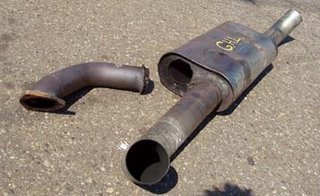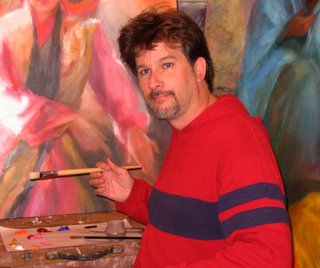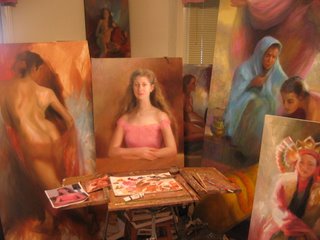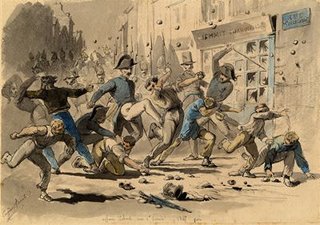A young French painter named
Jean Germain Drouais returned home from studying in Rome in 1780. He was asked by the Art Academy to present a humble copy of an old masterwork as proof that he had spent his stay in Italy wisely. At the time, all good students were required to dutifully copy a painting and deliver it to their professors as a final step towards earning their certificate of graduation. Drouais chose not to submit a humble copy to the Academy. Instead, he announced that he had created a billboard-sized original painting of his own making and It was this that he wished to submit.
The esteemed members of the French Academy were flabbergasted by the painter's arrogance. They refused to acknowledge such a brazen offer by a student. In short, they would not let him graduate. Drouais responded by telling them to go to hell. He announced to the Paris-elite that his huge painting would be on display in the parlor of his family home and that they were welcome to view it for themselves. This well-publicized act of defiance drew all the intellectuals of Paris to view the scandalous artwork. Even Thomas Jefferson, visiting from America, joined the intrigued crowds who stood in line to experience one of the first artist-launched independent exhibitions. Oh, the uptight Academy ultimately let Drouais graduate. Today his huge painting,
Marius at Minturnae hangs proudly in the Louvre Museum.
 Nothing says "revenge" better than getting your work in the world's biggest museum...
Nothing says "revenge" better than getting your work in the world's biggest museum... 60 years later, Paris was still the art capital of the world. A great many talented artists were working in the traditional neo-classical style which advocated smoothness, order and idealization. However, a painter named
Gustave Courbet did not work like everybody else. He had an especially unique vision of the world: He tried to paint things as they actually appeared in life. The curators of the formal annual salon did not look favorably upon his pictures. Courbet’s art seemed too raw and uncomfortably
real among all the other artists depictions of polished Venuses and smoothly lyrical landscapes. His nudes in particular were presented in a shockingly "in your face" style.
 Courbet's "The Origin of the World"
Courbet's "The Origin of the World" The curators rarely allowed Courbet to exhibit.
Instead of letting the rejection of his work defeat him, he did something remarkable. The painter fused art and courage. He rented a huge building located in the middle of Paris, where he displayed his gigantic paintings. He called his alternative exhibition "Gustave Courbet's Pavilion of Realism." It opened the same week as the official art salon and met with rave reviews. Thousands of people came to see his work, and helped Gustav Courbet to became a notorious celebrity. His two greatest paintings,
Burial at Ornans and
Portrait of the artist at work in his studio now occupy the central hall of the elegant Musee D’ Orsay in Paris.
A decade later, a group of young artists found that they too were experiencing barriers when it came to exhibiting their paintings within the confines of the official art world. They decided to put on their own show at an alternative venue. They asked their friend,
Nadar, who owned a camera studio, if they could use his place and hang some of their paintings on the walls. The camera studio seemed an odd place for an exhibition of paintings, but it had the distinction of being just around the corner from the very up-scale Paris Opera House. Even better, it was also directly across the street from the most elegant café in the whole city, Le Café de la Paix. Location,location,location...
 The bustling Cafe De La Paix
The bustling Cafe De La Paix
The group of artists sent out press releases and placed ads in newspapers. When their show opened, people lined up to view their strange new style of painting. Some of the viewing public responded negatively and the artists even considered hiring guards to watch the exhibit and to keep their art safe from physical attack.
A dismissing critic down-played the group by calling them merely
"Impressionists", but these artists gained much acclaim from their courageous independent exhibition. They decided to hold one annually for the next eight years, which cemented their reputations, making them all world famous. Monet, Renoir, Dégas, Mary Cassatt, Pissarro, Berthe Morrisot, Gaugin and all the other independent painters might have possibly worked in obscurity if they had not dared to make the first move themselves.
Let's advance forward to the dark years of World War I. In Zürich, Switzerland, a group of playful artists and writers gathered at the Cabaret Voltaire. They produced kooky, startling events and stage shows that challenged the accepted standards of the day. No gallery or respectable venue would have anything to do with them, but their self appointed spokesperson,
Tristan Tzara, was an articulate writer. He published a newsletter with reviews and articles about his friends’ new made up art movement, which they called..."Da-Da." They explained that Da-Da was one of the sounds that an infant would make. They believed that Art had to be reborn in an infantile form to cleanse itself in the face of mankind's infernal madness.
 Hugo ball wearing chic "Da-Da" duds for a performance.
Hugo ball wearing chic "Da-Da" duds for a performance.The international press picked up on these articles and their activities became famous. We must keep in mind that the Cabaret Voltaire was not a large performance hall. In fact, it was a glorified coffeehouse, approximately the size of a modern Starbucks. The "Da-Da" movement grew to become the "Surrealist" movement, which counted among its members Pablo Picasso and Salvador Dali. Both art movements defined the 20th century and were launched by artists who were courageous enough to take control of their own careers.
At the dawn of the twenty-first century, photographer Gregory Colbert and architect Shigeru Ban have built upon the model of independence by creating
Ashes and Snow. Colbert’s photographic works and motion pictures explore the spiritual relationship between human beings and animals. Architect Shigeru Ban created a 56,000 square foot cathedral-like temporary structure called the “Nomadic Museum” to house the exhibit, and thus bypass the over-booked and squeamish gallery world. Rather than taking the sardonic or oblique stance that many multi-media installations seem to have resorted to, Ashes And Snow aims at communicating warmth in an unashamedly direct way.
 "Ashes and Snow"creates a total environment for viewers.
"Ashes and Snow"creates a total environment for viewers. Hundreds of thousands of visitors in Venice,Italy, Manhattan,New York and Santa Monica,California have viewed the exhibit (and gladly paid an entry fee to experience a dynamic, undiluted vision). As the Nomadic Museum illustrates, people are willing to immerse themselves in art and pay for the privilege when it is presented as an alternative to the norm. Many people I have spoken with here in Los Angeles have even told me that they rarely find time to attend traditional galleries, but visited “Ashes And Snow” repeatedly, always amazed at the vast crowds and sense of community that it fostered.
All of these examples highlight a power that artists seem to rarely exercise.
They point to some of the relatively few artists who have stepped out of the framework of traditional expectations in order to reach people. These artists risked ridicule, professional embarrassment or financial loss to boldly make their personal statements. They had the audacity to by-pass the existing arena, and they had the audacity to succeed.















